What if everything you know about marketing is irrelevant in the 21st century? What if traditional marketing is dead, and marketing is evolving into something completely new and unexpected? That’s the premise of Robert Rose and Joe Pulizzi‘s provocative book, Killing Marketing. It’s a fascinating read that makes the case for killing off traditional marketing initiatives and transforming your marketing department from a cost center to a profit center. If that sounds a little heretical, it is. Robert Rose is my guest for this episode number 209 and he will explain exactly why he thinks you should rethink your approach to marketing and how you can turn a profit from it.
To give away a little spoiler, one secret is that you need an innovative content marketing strategy. If your marketing team can create content so awesome that people get massive value out of it, you can easily monetize your marketing and start generating revenue from it. Robert is a master content marketer. As the founder of The Content Advisory, Robert has worked with hundreds of companies including 15 of the Fortune 500. We all know that content is king, but if you want to make your content go ka-ching, stay tuned as Robert and I guide you through his ingenious strategies to monetize your marketing.
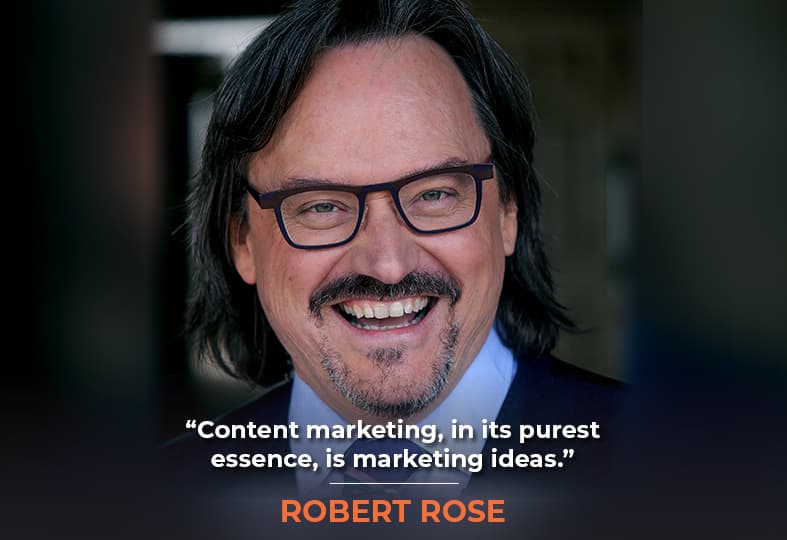
Transcript
Robert, it’s so great to have you on the show.
It is so great to be here. Thank you for having me.
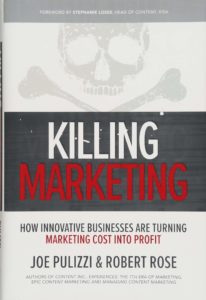
Let’s talk about content marketing, first of all. You got your latest book, Killing Marketing. I’m curious, how did you come up with that title and how does that relate to content marketing?
The title of the book is unapologetically meant to sell books, quite frankly.
You should put the f-bomb there then.
Yeah, because the world needs another one of those. When Joe and I were talking about the book, it was something that we quite frankly have seen over the last ten years where businesses were transforming marketing from a cost center into a profit center. Literally, a revenue stream for the business.
So we said, “There are gradations of that.” There’s everything from the too-often mentioned, red bulls of the world to other companies that aren’t getting as much press like Johnson & Johnson or Aero Electronics, who are truly transforming what marketing looks like in the 21st century.
We started with this quote that is attributed to Mark Twain—of course, he never said it—which is “It’s not what you don’t know that gets you into trouble, it’s what you know for absolute certain that just ain’t so that gets you into trouble.” We started with the premise to say, what if everything we know about marketing is actually wrong in the 21st century? What if we could evolve it into something different than we’ve seen.
Both of us being fanboys of classic marketing and advertising and steep in the education of classic marketing and advertising. Not for one section actually wanting to kill marketing, but maybe to rebirth it or renew it as if it were as something different in the business. That was the thrust of the book.
The original title of the book was called Marketing Profit which the publisher loved by the way. Both Joe and I thought, “Oh God, that’s boring.” And so we said, “What if we just called it Killing Marketing?” because that will hopefully sell more books. We will put a skull and crossbones on the cover, and make it look like a novel. It worked. Here we are.
Was that profit profiting from marketing or was that profit like you were foretelling the apocalypse of marketing?
That was the original clever conceit. We would maybe cross out the word profit with the f and put in the phe, all of that. It just seems too cute, to be quite honest.
Cliche like dropping the bomb in the title.
A little bit. That was the idea. What it really came down to was, to answer your question, is when we started thinking of the idea of reformulating marketing full stop, really at the core of that was how does the business handle it’s own media, it’s content, and really get strategic about using that as a means of strategic value for the business. That’s where it plays in the idea of content marketing.
One thing I’ve noticed in terms of content marketing is it seems a little skewed towards big corporates. You just name-dropped several examples of big corporates and probably our listener is not from a big corporate but a smaller business. Most businesses in America are after all small businesses.
What would you say to a small business owner, or a marketer at a small business, or marketing consultant who has their own small business who consults with other small businesses? What would you tell them about the relevance of content marketing? That it’s not just about the big companies? That it’s not just about turning this huge tanker around because they are nimble? They are small and they can implement stuff. What’s the problem that they need to solve and content marketing is that solution, that magic pill?
Content marketing, in its purest essence, is marketing ideas. Share on XIt’s a great question. The answer is that content marketing is probably even more relevant for smaller businesses than it is for bigger businesses because it can be the way you differentiate and get the reach that small businesses typically have trouble attaining. What I mean by that is, when you start looking at your small business as a platform that can engage your audience, whether they’ll be locally-focused, regionally-focused, or even globally-focus. But you just happen to be smaller in size, it becomes a way when we small businesses either don’t have the money to spend on paid advertising or PR, or some of the things that our larger competitors or global companies will have the bandwidth and resources to spend on. It becomes a differentiating tactic.
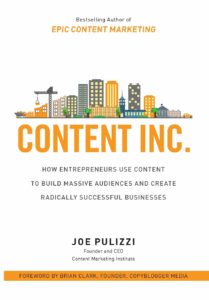
For example, my colleague, Joe, wrote an entire book on this called Content Inc., which is all about small business and the mandate for content marketing and how it plays such an important role. I started my career as a CMO for a small software company. We were ten people and we were trying to become the classic, wonderful startup company venture-funded and all that stuff.
The one thing I realized when I became CMO of that company was we were never going to be the companies in our space because at that time, I was a small business and I was competing with Microsoft, Hewlett-Packard, OpenText, IBM. All those giant companies were always going to outspend me, always going to out-SEO me, always going to outbrand me. But what I could be that they couldn’t be or that would take them time as you mentioned turn the monolith, they can’t be the expert. They can’t be more of an expert than I can be.
In other words, I can be a mile of two miles deeper on any one topic that they can be because I have the knowledge, expertise, and passion for my topic. When I was the CMO of the software company, that’s what I did. I said, “Look, when we get invited to the table to talk to customers about what we do, we are just going to be the most expert thought leader in our space.” Instead of quite frankly, creating as much as paid advertising as I could, I put as much as I could into building a platform that wanted to draw in audiences and engage those audiences so that ultimately when they made the decision that my type of software was something they needed, I would be in the consideration set.
Marketing content, I mean that term purposely. In other words, marketing ideas. Marketing thought leadership is just easier than trying to market your product against the headwinds of the products and services that are competitive. Because that is when you are on equal footing with everyone of your competitors or independent of sizes on the quality and independence and the value of your ideas and your thought leadership.
For any small business, my advice is to, look I’m a student of classic marketing and I love classic marketing and I think you should be part of the portfolio of our integrated marketing mix at every level. But at some level, having a healthy content program for any business of any size is an important part of your integrated marketing portfolio. You just needed to decide on how big a part of the portfolio is going to be.
That makes a lot of sense to me and I hope to our listeners. I think a great example of this, is the one that I share when I speak a lot of times doing workshops. And that is if you can influence the buying criteria of the audience. Let’s say that you are selling baby furniture online and you can get to those expectant parents earlier before they started thinking about the crib or bassinet for the baby’s room.
But early, perhaps they just got back from the ultrasound where they found out the sex of the baby and now they are going to type something in Google, what is it that they are going to type in? I wait for a moment and something finally comes up with baby names. Right, yes exactly. That’s way more popular to search than baby furniture, or baby cribs, or any other more relevant keywords for you as the hypothetical baby furniture retailer.
This is where you are going to sneak up on your competitors because you can set the buying criteria if somebody comes to your baby names resource area on your baby furniture site. It’s so valuable, great content marketing. Then, on the side or a pop-up, you have this irresistible offer of an essential nesting checklist. The 30 or whatever things that you need for your baby’s new room.
Then it walks you through on how to pick the right crib. Should it be wood? Should it be metal? Should it have baby bumpers or not? Etc. They had no clue beforehand and, of course, you are going to steer them in the direction of your crib, but it’s a soft-sell.

It couldn’t be more true. Let me give you two other examples of this because what you’ve just outlined is the wonderful and very valuable search benefits of being able to rank much higher for that which your customer cares about rather than what they don’t care about.
Only ranking on the kinds of products that you serve such as whether it be cribs, baby chairs, or baby furniture, and you are trying to compete with the other large baby furniture companies out there. It is going to be tough, but before your customer is looking for baby furniture, you are exactly right. They are looking for answers to your questions about the things that presage the need for baby furniture.
You are now giving them the value through education, inspiration, or entertainment of that content. You are now going to be on top of that consideration set when they are on the bind market. There’s that aspect to it. The other is quite frankly taking advantage of the ability to build content products that actually differentiate you in the market space.
I’ll give you two examples of that. One is solopreneur and her name is Trish Witkowski. She is basically a consultant that does folding paper. I’m not even joking. As you might imagine, her clients are direct mail companies that do really cool folded elements for marketing campaigns. What she did was to advertise her services. She created a video series and a podcast called the Fold Factory. She has a weekly show on YouTube that’s called The Weekly Fold. Literally, a weekly show focused on a cool way to fold paper.
Now you go, “That’s crazy.” But she built up such a loyal audience that, (1) it’s feeding her consulting business, but (2) and more importantly, the loyal audience is at such a size now where she can actually charge money for advertising to create the show. She has sponsors of her weekly fold show. Her marketing is actually generating revenue which is actually helping her get more consulting clients. That’s the whole idea behind Killing Marketing.
Another one, just to round up the examples here, is what the folks at Terminus have done. Terminus is a small software company focused on account-based marketing. Small startup, a handful of guys trying to get into enterprise software for account-based marketing. They started their company by starting a blog, then a podcast, then an event, and they all named it around this content brand called Flip My Funnel brand. The Flip My Funnel Podcast and the Flip My Funnel blog became popular enough that they did transform that into a physical event called the Flip My Funnel Event where you can learn all about account-based marketing.
In the event, they got 600 people to show up to the event. They got sponsors. Even some of their competitors, they had to sponsor the event. They had other people who wanted to get in front of marketers obviously for account-based marketing sponsor the event which mitigated all the cost of doing the event.
Of course, they invited prospects and existing customers to the event as well. They closed 20 new customers at that event which is more than paid for the effort. They now have investors, venture people coming in and saying we just want to buy the content brand.
So now they separated the company into two companies. One is the content brand called Flip My Funnel. The other of course is the software company called Terminus. You do not have to be a big company to make this a big thing for your business.
That’s awesome. I love those two examples and it really showcases how you can turn the cost center of the typical marketing department into a profit center. You don’t have to give other examples but I’m just curious if there are other types or ways of creating profit centers out of the marketing function or is it really pretty much around starting a podcast, getting sponsors for that or putting on an event and getting sponsors and attendees for that?
No. What we have been talking about for the last couple of minutes here is really what Joe and I typically call the direct revenue or direct savings model of transforming marketing into a profit center. But when we take a step back and we look at some of the other values that you can create with this idea, the thing we look at is we say, “What is the difference between regular, straightforward, direct marketing, advertising, and content marketing?”
The primary difference is that direct marketing and advertising is an expense. Every small business owner understands that. It is an expense. It is typically the last expense that a small business owner wants to spend because it’s taken directly out of their pocket.
Content marketing is even more relevant for smaller businesses because it can differentiate you from the others and get the reach that small companies typically have trouble attaining. Share on XThat expense is either efficient or not efficient. It’s a financial metric. It’s a typically financial value marketing. When we look at content marketing, it provides strategic value. In other words, it’s very much like a brand. It’s very much like your product itself. It provides a multiplier to what it is that you are doing to acquire new customers.
What I mean by that is, for example, in this J&J, we mentioned Johnson & Johnson a little earlier as a good example of this. Their babycenter.com platform which runs as a separate business with a separate profit center to a separate division of J & J, and actually makes money through banner ads and all of that. But that’s not the primary value that J&J uses it for. What they use it for is they engage an audience and by most estimates, they reach between 30-40 million moms and dads all over the world.
They use it as an R&D to make all of their other marketing efforts cheaper. More efficient. More effective. For example, they are going to run a big digital media campaign and run banner ads and an ad campaign. They can go out and test headlines before they go and spend the money. So they can test whether sleep through the night, sleep overnight, or sleep tonight is a better headline and A/B test those headlines before they spend millions of dollars before they go out and buy banner ads.
Using the first-party data and our relationships with those audiences to make media buying and media strategy more efficient or more effective is a great way to save cost and provide a strategic value for the business and basically transform that content marketing effort into something that makes the entire business more efficient and more effective by basically building an asset called an audience.
There’s a lot of stuff we could talk about there. Saving money on the media cost, you mentioned organic search. We could talk about how it creates a customer that might buy more products because you’re teaching your customer how to leverage your product more efficiently or effectively. Teaching them how to use it more or buy more accessories that goes with it. Tons of stuff to talk about educating, entertaining, or inspiring your audience to do things in your favor. That’s what a great media platform can do for you.
In fact, I was just thinking that you could even use a platform like that for competitive intelligence because the industry is going to come knocking on your door saying, “Hey, we want to advertise with you. We want to do sponsorship. We want to do joint venture deals, or strategic alliances, or co-marketing, or whatever.” They could be guests on your podcast. They could be contributors to your blog and produce video content for you and so forth. You could learn a lot from your competitors by having a site like this.
No doubt. It’s a great point that you made there. In fact, I know we had a client that was using it for something very similar to what you are talking about there which was to basically use their content marketing platform as a radar system about all the places that they were putting their paid media dollars.

In other words, they were buying the media on XYZ magazine, this journal, this website, this email newsletter, etc. So by pulling those people in, typically we are going to look at them equally. In other words, we are going to look at those clicks and visits to our websites for those banner ads as an equal thing. Then, hopefully, some of them turn to leads, or opportunities, or they fill their shopping carts, or whatever.
What this company did was start to use some of their media money to advertise their content platform, pulling that traffic over, and actually then profiling those users by having them subscribe to the blog or to their content platform and seeing not only how many each one of these paid advertising campaigns were pulling in but who and what quality of people.
What they found was that some of the places they were putting their most money because it was getting the most traffic was quite frankly sending them competitors, people looking for jobs, people who weren’t their target market at all. It was the most traffic-producing media buy, but it was quite frankly the worst audience-producing media buy. They re-put their money into some of these more niche advertising opportunities and found that while the traffic was lower, the quality of audience they were getting from those platforms were much higher, optimizing their media based on quality of traffic, not on quantity.
That’s really cool. That also gave me an idea that if, let’s say, you’re the baby center of your industry, then you could go to organizations that put on events, conferences, trade shows, and so forth and say, “Hey, we want to be a media partner.” If it’s a big trade show, the media partner is essentially getting sponsorship status, is getting a lot of visibility at the show in exchange for covering the show. There’s no cost involved for that media partner. It’s all upside.
Such a great point. Absolutely yes, 100%. We certainly have that happening at Content Marketing World and I’ve seen it at another conference. It’s a genius move. Many times, I have small companies come to me saying, “Yeah, we can’t really afford to be at XYZ show,” and I’m like, “Why don’t you have a media property, get a media sponsorship, do interviews, and do the whole thing there?”
So true. That’s awesome. That also reminds me of a situation with a past client of mine I’m actually an investor in because they paid me partially in stock in their company. That is CODAworx. What they do is very innovative. They partnered with a popular magazine in their niche. They started as this company originally called The Art Commission. The idea was if you are sourcing an atrium lobby sculpture or some big piece, you need it commissioned. It’s going to sit on your corporate headquarters in the lobby or whatever. Then, how do you find that opportunity? How do you find the artist? How do you narrow it down and so forth?
They were filling a niche in that regard. Then, they realized they could partner with this magazine. The magazine is Interior Design. They put on annual awards in conjunction with Interior Design magazine. The magazine promotes the awards. It’s a real partnership for this annual event and for all the work that goes into that in terms of selecting judges, getting entries. They get incredible entries to come in every year for these awards. It’s the CODA awards, the Collaboration of Art and Design or something.
It sounds awesome.
It’s like the collaboration of art and design brought together and they want to see incredible entries of these commissioned artworks that bring design and art together. They get such great entries. They just get such incredible entries every year.
That’s something that I think is really something outside the box and if you’re a content marketer instead of just traditional marketer, seeing marketing as cost-centered, you wouldn’t come up with those kinds of opportunities.
The advantage of today's content marketing is that you don't have to be a big corporation to make it on the internet. Share on XNo. You wouldn’t and it is an incredible opportunity for so many businesses. Just as a quick corollary to the example you just mentioned, I know and I am forgetting their name off the top of my head, but it was a cable and telecommunications provider and in some locations, I want to say it was in South Carolina or North Carolina somewhere, they put together an awards program for small businesses and the whole idea was that they could provide a platform through all of the things they do.
In other words, through local news, through PR releases, and through all of these things to highlight the value of these cool small businesses that would apply and also develop a better relationship with the small businesses who buy telecommunications, cable services, and internet services from this company. So, it became a program. This awards program became a way for them to say, “Hey, listen. We are here to celebrate you as our audience.” As a result of that, they got better relationships with the small businesses that are going to need their services.
That’s awesome. How do you increase average order value with content marketing? Maybe you can have an example of this where the average order value is $100 and by doing some content marketing initiative, you’ve increased it by 100% or something like that.
Exactly. I absolutely love this aspect of content marketing because it’s a place where there are not a lot of businesses that focus, which is really teaching customers to be better customers. What you are doing is you are either teaching them to buy more or engage more deeply, or once they become customers, to up their subscription or re-up their subscription, or to be quite frankly increase the number of transactions they make with you.
I can’t think of a small business off the top of my head that’s a good example of this, but I will tell you about a very business that does this so well, which is TD Ameritrade. They’re a stock trading platform. One of the things that they created was a print magazine and they actually got the print magazine from an acquisition that they had made which is a software company they bought.
They got this print magazine called Think Money Magazine. The Think Money Magazine was this wonderful print magazine. Of course, they were thinking of killing it because everybody’s thinking about killing their print magazine. The VP of Marketing said, “Well, no. Let’s not kill it just yet. Let’s just change it and let’s start sending it only to customers who sign up for the trading platform.” They did that. They basically reduced the number of magazines they were producing by only sending it to customers.
They would mail you a magazine. I think it was monthly after you sign up. What they discovered is that your average trading velocity when you sign up for TD Ameritrade was one time per week. Then a few months, three or four months after you start receiving this magazine, which of course teaches you how to be a smarter and savvier trader, your trading velocity goes up to five times per week.
They quintupled the average trading velocity of their average customer which of course they make money in each trade and created a stickier customer and a better customer by simply sending them this print magazine. It’s been such a success for them that they now repurposed that content. Tweaked it a little bit and they’ve now launched what they call their Ticker Tape Blog, which is now a top of a funnel experience really targeted toward teaching those who know nothing about trading about why it’s such a cool, fun, interesting, and valuable thing and getting people to actually sign-up. They are using the same content for two different purposes.
Great example. I love how they’re leveraging a seemingly dead or dying medium—in this case, a print magazine—as a way to differentiate and add value in a unique way. That reminds me of a campaign that I read about years ago from the MarketingSherpa newsletter. It was a direct mail piece. It commissioned someone to write a song called, Let’s All Blame the Marketing Director. This was at a time when there was a recession or downturn in the economy and a lot of marketers were losing their jobs. The marketing function was getting cut or their budget is reduced.
People were feeling the pain and they sent this sheet music. It was a barbershop quartet-type of song that they had commissioned. They sent the sheet music in a semi-translucent envelope. You could see that there was sheet music when you receive this in the mail and you could even see the name of the song.
That was curiosity-producing for the recipient. If it’s a marketing director, this would probably get opened. Then there was a reply postcard to get a CD of the commissioned music so they actually commissioned a barbershop quartet to sing the song.

That’s beautiful.
Isn’t that genius?
That’s a cool project. I love that.
They got a ton of great leads out of that and Far and Way paid for the cost of the campaign. Really great ROI on that. That was back in the day when CDs still made sense. But what a genius approach and really resonating with the fears and concerns of the recipient. Really clever in taking a medium that wasn’t considered cutting edge, even at that time. In this case, direct mail. That’s a great example. I still remember that even though I read about that years and years ago.
That’s a cool example.
Do you have more examples of taking something that is seen as dead, or dying, or just unusual? Here’s another example that’s unusual use case for direct mail and that was from my previous company, Netconcepts. We would send out FedEx tubes with a pair of Will Hunting socks and a cover letter explaining how Cabela’s was a client. “We got them ranked number one in Google for men’s hunting socks, will hunting socks, all these different variations. Here’s a pair of Cabela’s men hunting socks for you.” We got some really nice results out of that. I don’t remember the ROI numbers, but again Far and Away paid for itself.
I’ve done that before when I was working for an agency. We did that all the time. We did send them the left shoe and then the right shoe comes if you schedule a meeting. We did one where we sent them a putter, but if they were to come and attend and see us inside the booth, they would get the driver to go along with the potter and all kinds of those. Those are fun. Those kinds of campaigns.
Who gets a FedEx tube in the mail? You will get a FedEx letter. Those will get opened most likely, but probably by the gatekeeper. A FedEx tube sticks out. I remember interviewing Dan Kennedy on this podcast who recently passed away, unfortunately. What a genius marketer. He was talking about the power of the lumpy envelope gets curiosity-producing. Gets people interested in opening it instead of, the first thing that you do when you get your mail is you stand over the recycling basket to dump most of it. If you get a lumpy envelope, that’s more likely to get opened.
Sure, of course. You want to know what the heck is in it.
Do you have any examples of taking something that’s unusual, or seen as not cutting edge, or maybe too cutting edge, and it just stands out as something unusual?
I don’t know how unusual it is, but the one I will mention, I won’t mention their name, but it was a company. A small business that I actually did some work for back aways. Depending on what you are thinking or attitude is about these debt consolidation places, this is what they did for a living. They basically were a finance company that did debt consolidation and provided people a way to aggregate all of their credit card debt altogether and pay one loan.
The story I love to tell there is that, we were trying a content marketing program there and it wasn’t anything revolutionary. It was simply a series of webinars and a resource center that we created for them and educate people on how to go through manager finances. Sort of finance 101, how to manage debt, how to manage a budget. Basically just teaching people personal finance responsibility.
I’ll never forget the CEO told me. Their main marketing effort at that point was having people go through a list of people who were defaulting on their debt and just calling them. He said, “Our average close time is two hours because once we get them on the phone, they’re in. They sign up. Almost everybody signs up.” I said, “Great,” and he said, “That’s what you got to be,” and I said, “Well, let’s talk about that.” We set up, we did the content, we built in basically a 6½ month program to get some traction with it.
Optimized base on quality, not quantity. Share on XSo, 6½ months later, cut to, the CEO comes walking in, he’s got a stack of papers, and he slams them on my desk. He says, “We can’t afford to do this anymore,” and I said, “Why not?” He said, “Look. Basically, the time of close of these people who went through this program versus who went through their normal cold calling went from two hours to two weeks. He said, “That’s just way too long. That’s too high a cost of sale for us,” and I was like, “Wait for it,” I said, “Let’s look.” and what we noticed was, their churn rate, in other words, the people who signed up, who basically then quit one month later their program, was basically at around 50% or 60%. Of course, there’s a cost there. There’s the cost of onboarding them, having customer service get in touch, do all their aggregation of debt, blah-blah-blah, big costs there, and 50% of them were churning out.
Then we look at the people who came through the education program and that had dropped to 15%. There was a delta there of 35% of the people who were actually getting close, who were actually sticking around. Of course, that save them cost and onboarding, but also basically, they’re creating longer-term customers. For them, measuring against the metric of how long does it take to get a customer’s butts in the seats, was the wrong metric to measure with content marketing and this was a much better measure of the value of it.
That’s great. That reminds me of something I learned from Mike Moran, who worked at IBM for many years. He told me that they had to come up with metrics that were meaningful for a very long, offline sales process. Something that would be like a seven-figure consulting deal type of sale would not happen online. They’re not going to add to cart and then checkout and pay by credit card. It’s going to take months. It’s going to involve many touchpoints and a lot of assists. They found various milestones in the process, like for example, early on in the process, white paper download.
If a white paper download is, let’s say, on average worth $100 because it’s a seven-figure sale and X% of the time the white paper downloader converts to the consulting contract over a 6- or 12-month time period of negotiation, then they can use that white paper download number of, let’s say $100, to start doing ad campaigns or partnership deals or whatever kinds of investments in marketing because if they can get a certain number or whatever the threshold is that they’re looking for in terms of white paper downloads or white paper downloaders, then it pays for itself. They did the study beforehand to find out that that’s what it’s worth and that’s pretty clever.
It’s extraordinarily clever. It just goes to show you the key to all of these examples we’re talking about here is, the first one to deliver value wins. If you can deliver value to your customers, it is one of the most differentiating things you’ll do. In today’s world where we’re talking about the level of trust that people have in content news, information, entertainment, even brands, even our friends on social media, if you’re delivering value through content, it’s different.
It’s a different thing and all the things we’re talking about here are certainly, while in the hindsight, they feel clever, they’re all things we thought of doing. There’s nothing here that’s totally revolutionary that is going to upset the world balance of anything. They’re not all expensive things to do either. That’s what’s so great about this, it’s just thinking about first, “How can I make my buyer’s journey and my customer’s journey a little more elegant, more interesting, and more valuable?” and thinking about what passion I have for making that happen.
It puts the customer or the prospect first. Let’s say, you’re facing the customer, you actually have your butt to the company and that’s a hard thing to do for many people because they’re afraid of losing their jobs. If I’m company-focused, I’ve got a job. If I’m customer-focused while I get my butt to the company and I’m going to do things that are in the customer’s best interest, but not necessarily in the company’s best interests—reminds me of the principle of pre-eminence from Jay Abraham—if it makes more sense to send that prospect to a competitor because they will be better served, then you should do that. That’s going to cost you some revenue in the short term, but all that business karma is going to add up and you will win in the end.
It’s got to be about the customers, so face the customer not the company and ultimately everybody wins and hopefully, you won’t lose your job in the process. Listener, if you’re interested in learning more about pre-eminence and Jay Abraham’s principles, definitely check out the interviews of him on the show that are fabulous, including the one that was from 2015 or 2016.
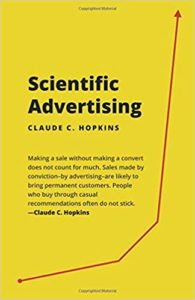
Let’s switch gears and talk about more classic marketing and classic advertising. I’m a big fan of the classics. I think it’s incredible what you can learn from books that are decades and decades old, even from the 1930s, or 1940s, 1950s. Scientific Advertising by Claude Hopkins. That was from 1923, that book. A newer book but absolute classic that every content marketer and copywriter should have on the bookshelf and actually read is Breakthrough Advertising by Eugene Schwartz. There’s The Ultimate Sales Letter by Dan Kennedy. That’s not from the early 1900s or whatever, The Boron Letters by Gary Halbert. John Carlton’s Kickass Copywriting Secrets of a Marketing Rebel, that’s a classic. What are some of your favorites?
Oh my God, now you’ve hit upon my jam. I am a passionate avid student of business strategy and marketing from way back. I could regale you for an hour on this stuff. First and foremost, Theodore Levitt, who wrote a number of books, but Thinking About Management is one of them. The Marketing Imagination is another of him. He is the guy who you’ve heard the quote a million times, who said, “If the railroads wouldn’t have recognized they were in the transportation business and not the railroad business, they wouldn’t have died.” He’s the guy who said that. Then we go from him to maybe, Peter Drucker, of course, anything by Drucker, Practice of Management probably being the one that is most famous of Drucker.
What’s your favorite Drucker quote?
My favorite Drucker quote is, “There are only two functions of the business: marketing and innovation. Everything else is a cost.”
I love that. That’s a great one. How about, “What gets measured, gets managed.” That’s a great one, too.
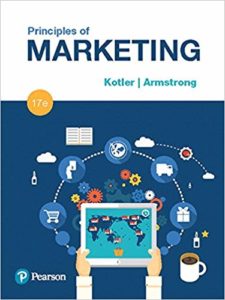
Exactly. Then, of course, I would be remiss if I didn’t mention Philip Kotler’s Principles of Marketing book, all 12 editions, I think it is now, 12 or 13 editions of it now. I think mine is number seven or something like that is dog-eared and it’s just amazing. He wrote a book, actually, called Marketing 4.0, which I absolutely adore. It’s a great book, just unbelievable. There are many others.
Well, of course, there is Joe Pulizzi.
I don’t know if I’m putting him in that category. Pulizzi is good for a laugh.
No, he’s awesome. Actually, he was a guest on the show. You guys have a fun relationship. Okay, so how many books have you guys co-authored together?
We have co-authored two and I’ve written three.
Okay. Joe Pulizzi, the guy who coined the term, content marketing, I believe, right?
Well, it’s arguable whether he actually originated the term but he certainly is responsible for making it a standard. I would say, he standardized a term that was being bandied about. I would say he is the standard-bearer of the term and made it part of the collective lexicon of marketing.
So if you, as a listener, care about content marketing, of course, you need to check out the Joe Pulizzi episode on this broadcast as well.
There you go.
Any other favorite books that aren’t necessarily in marketing, or in copyrighting, or anything like that, that are just transformational or very helpful books?
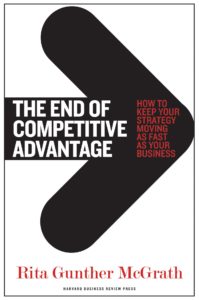
Okay, we can go down this road, too. Again, you hit upon my jam. So, anything by the author, Rita Gunther McGrath. There are two books I’ll mention in particular of hers. One is called The End of Competitive Advantage, which is just an amazing book. The second is a much more geeky book, you’ve got to really be into business process management and strategy creation to get into this book, it’s called Discovery Driven Growth. Discovery Driven Growth has quite frankly been the foundation of how I’ve set up my consulting practice. It’s an incredible book.
I would also mention a book by Youngme Moon. She’s out of the Harvard Business School. She wrote a book called Different. One of the best books on branding that I’ve read probably in ten years. I’ll think of a couple more here.
While you’re thinking of a few more, I will chime in with a few of mine. I love Freakonomics, I love Never Split The Difference, which is all about negotiation.
That’s a good one.
Yes, Chris Voss actually was a guest on the show. That was an amazing episode. Never Split The Difference is the best negotiating book out there, I think.
It’s a great one.
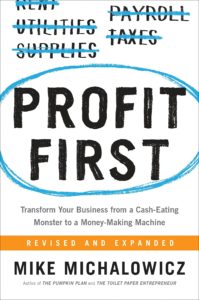
Also, Profit First, which I’m listening to right now. I’m more than half the way through that book and I’m implementing it, which is pretty important because you could listen to a book or read it and think, “Wow, that was good stuff,” and then it’s just a reference. No, you’ve got to implement the system of Profit First. Mike Michalowicz is the author of that book. That’s a game-changing book. I just interviewed him. That’s going to be on Get Yourself Optimized, on my other podcast, which is about life optimization, career optimization, relationship optimization, just up-leveling your life in various ways. Those are a few of mine.
I would mention from sort of the upper level, you’ve got the Dan Pink books. Drive is a great one. Then, I would be remiss going back to the classics, as it were, to have not mentioned The One to One Future by Dr. Martha Rogers and Don Peppers. They’ve written a number of books together which are great, but The One to One Future, I think, is probably the most seminal business book of our generation.
The reason I say that is because if you look at The One to One Future, it is everything that we’ve spent our time over the last two decades trying to live up to. They’ve really invented the entire concept of what we now call CRM.
Peppers and Rogers grew up in the early 90s.
That’s right. The One to One Future was written in 1994 or 1995. It was basically how to think of building and using technology to drive better relationships with your customers and have a one-to-one relationship with your customers. It’s what gave birth to companies like Siebel and ultimately Salesforce, and ultimately by companies like HubSpot, and all of the things that we think of today as managing and using technology to manage a closer relationship with not only customers or prospective customers. It all comes out of that book.
I remember learning about them when I first started in 1994 was when I started down the whole marketing path. I dropped out of my Ph.D. in biochemistry. I started an agency in early 1995. Peppers and Rogers, they’re awesome.
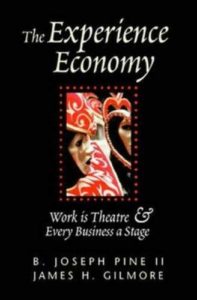
And then The Experience Economy, I would mention as well, which is also another older book and it was Joe Pine and James Gilmore who wrote that. That was really the inspiration for me to write the book, my second book, the one I didn’t write with Joe actually, which was called Experiences: The Seventh Era Of Marketing. That was the inspiration for me and people forget that that book came out, the ideas came out in the mid-90s, 1997-1998, but the book was published in 1999. It kind of got lost in the whole dot-com explosion but such a great book and very prescient.
Awesome.
You read all those and you’ve got yourself an MBA in marketing and business right there. I will tell you, if you read all those books, it’s amazing.
Or if you just listen to all of my 209 episodes of Marketing Speak, either one. You can do one or the other.
Well played.
Yes, well played. Let’s talk about another term that’s been bandied about, content marketing is one of them, but how about native advertising? How do you feel about that term?
I’m fine with it actually. It’s a little bothersome when they get conflated together, the idea of content marketing and native advertising. Those are two very different things. I’m seeing a lot of successful efforts with native advertising. Certainly, a native advertising campaign and/or program can be part and parcel with promoting a content marketing effort. The difference is primarily that, native advertising is simply paying for the placement of valuable content on someone else’s platform and content marketing is the usage of the content on your own platform.
What bothers me about the implementation of native advertising sometimes is the way that they try to fool the consumer, or the visitor, or the viewer into thinking that it is editorial content when it’s actually paid advertising.
Yes, that’s exactly right. I wrote a post a few years ago which I think is still relevant today or at least I hope it’s still relevant today, which basically said, “Native advertising should be neither.” This speaks to your point well, which is one of the descriptors of this is native. Meaning, it needs to be so invisible as to be indistinguishable from an editorial in the magazine or platform that it’s being put on. I couldn’t disagree with that more.
In fact, the idea is that, if I’m going to create content that’s going to be on someone else’s platform, I not only want them to know that it’s mine. If I’m serious as a marketer here, I don’t care about the rest of the magazine. In other words, if I’m going to write an article that’s going to appear in the Wall Street Journal or New York Times, I want it to be so good, so different, and so identifiable as coming from me that people go, “Who is this and where can I get more of it?” Quite frankly, what I’m trying to do in a native advertising scheme is to steal or borrow the audience from that native platform.
I want the thing to stand out. I want it to be identified as being from me. I want people to know that it’s from my brand or from one of my thought leaders or identifiable with me because quite frankly, I don’t want it to look like the rest of the publication, because why would I write to bolster their audience? I’m writing to bolster mine. That’s why I think it should be neither native nor advertising. If I have trouble with the term, that’s the trouble with it, but I have zero problem with the concept. Certainly, it’s been around forever like content marketing, we used to call it advertorial, but it’s certainly very viable done, but as you point out, implement it well.
The concept is great because you are adding value. You’re educating, you’re entertaining, you’re helping the consumer, or the visitor, or whatever.
Melanie Deziel, who’s just a fantastic thought leader in this space. She came from The New York Times and one of her big claims to fame is that she did that amazing piece for HBO’s The Orange Is The New Black show, and she had a series that ran in The New York Times which was about women in prisons. It was an incredible journalistic piece. It was just a really good informative article about women in prisons. It just so happened to be sponsored by Orange Is the New Black and HBO.
The first one to deliver value wins. Share on XNice. That’s great. You can make a difference in the world by just getting advertising dollars to help fund getting an important message out there.
The other thing about native advertising is that it is a co-created effort. You are not only writing the content or creating the content that’s going to appear, but you also have to depend upon the way that it’s going to be displayed by the publication itself. To your point, the implementation is not just on the marketer, it’s on the backs of the publisher as well. I won’t throw anybody under the bus here, but there are definitely, especially in the small business and business and marketing space, publications that do not do this very well at all.
And then there are ones that do a great job of this.
Exactly.
Internet Retailer Magazine does a great job with this. I did a full-page ad in their June issue which is the issue that came out right when Internet Retailer Conference and Exhibition (IRCE) happened. It was a great piece and was very unusual because it was kind of an expose of thought leaders doing innovative SEO, nonprofit founders and so forth. Some really innovative folks including President Jimmy Carter. I worked my way into each story because for example, the reason that President Carter started blogging—he was the first ex-president to blog—was because of me.
I was donating or volunteering, helping the Carter Center with SEO, online marketing, and so forth. This was early days of blogging, 2003 or something like that. These trip reports that President Carter is doing, they need to be blog posts. He needs to be a blogger. That will get you a ton of visibility and data, and sure enough, it worked like a charm. So, putting those kinds of stories together in an article and then having a sponsored content, or advertorial kind of messaging at the top of the article. That is I think an example of native advertising in a traditional medium, in print.
That’s a great one.
Now, you guys have an awards that by the time this airs, will have just happened, the Content Marketing Awards.
That’s correct.
I entered a few campaigns and I got a finalist for my other podcasts for Get Yourself Optimized, which is pretty cool.
There you go.
How does the Content Marketing Awards help the Content Marketing Institute with its content marketing? It’s kind of meta, isn’t it? Like you’re eating your own dog food, so to speak. How does that play into the bigger picture?
It is as you might expect. Just a few things. One, it’s a revenue generator. You had to pay in order to submit your award in. The second thing is that it’s also obviously an organic content generator. In other words, all of the awards submissions are story ideas that we can leverage and create an editorial calendar, and we do, on not only just the winners, but also many of the applicants. They become great ways for us to evangelize the wonderful work that’s being done in content marketing all year long. It’s almost like getting paid basically for people to submit the editorial ideas for us to cover in the next year.
The third benefit is the butts and seats to Content Marketing World because if you’re submitting yourself for an award, you’re much more likely to actually come attend the event and, of course, attend the award show to see if you won. Then, of course lastly is that it’s a way for people to share the wonderful goodness that is everything about CMI, our brand, and all of that, because if you’re submitted for an award, and if you win an award, you’re much more likely to share that on your own blog, on your own social media channels, and thus giving us more reach to a wider audience than we might have before. There is nothing but goodness around the awards that we put together.
The concept, I think, that’s really important to underline here is that, if you get people to shout from the rooftops about your institute, your awards, your events, whatever it is, because it’s in their own self-interest to do so. If they’re scratching their own itch, that’s the best way because then you don’t have to prod them, you don’t have to beg them, you don’t have to bribe them, you don’t have to keep bothering them. You don’t have to come to them like a beggar which most of these outreach campaigns are like that. “Hey I’ve got a great guest post I want to contribute to your blog,” I hate those. I hit delete all the time because they’re not adding value, it’s all about the get instead of the give. If it’s in my own self-interest to tell the world about your amazing thing, then just get out of the way and let me do it. Just set it up so that I’m going to do that rather than try and chase me for it.
That’s exactly it. What happens with awards is that they get better every year because they get more respected every year. As long as you maintain the integrity of the awards and the awards show, then it becomes a core element, a content pillar for you. You get more prestigious companies applying for the award and it just builds on itself. Now, that we can say that we’ve been doing this for 10 years, people are excited about it, people are excited about winning it. It’s not just some goofy little thing where you get a little trophy, it’s a real deal.
It’s legit. Well, this has been fabulous. I really appreciate you being on the show, Robert. If folks wanted to learn more about you and what you offer, or Content Marketing Institute, or about content marketing in general, what are some of the places that they can go to dig into all of that?
Well, you’re very kind. I guess the best place to send everybody would be to our website which is, of course, tca.inc, sporting our fancy new domain there. That’s the content advisory. That’s where we have all of our blogs, all of our resources, the home of our consulting, advisory, and education services. Of course, I would be remiss if I didn’t mention the Content Marketing Institute which is contentmarketinginstitute.com, and then if you want to connect, I’m on LinkedIn. I’m easy to find. I’m just Robert Rose on LinkedIn and on Twitter, @Robert_Rose is my handle there. I would love to connect with everybody there as well.
All right, awesome. Thank you so much, Robert, and thank you, listeners. Now, get out there and do something with this incredible knowledge. Get out there and add some value to your consumers, or customers, or target market, and we’ll catch in on the next episode of Marketing Speak. This is your host, Stephan Spencer, signing off.
If you liked this episode, I think you’re going to love the interview I had with Joe Pulizzi which is episode number 12. Joe, if you recall, is Robert’s co-author and he’s basically the godfather of content marketing.
Important Links
- Robert Rose
- Robert Rose – Linkedin
- Robert Rose – Twitter
- Content Marketing World
- Content Marketing Awards
- Content Marketing Institute
- The Content Advisory
- Dan Kennedy – previous episode
- Jay Abraham – previous episode (2015)
- Jay Abraham – previous episode (2016)
- Joe Pulizzi – previous episode
- Chris Voss – previous episode
- Killing Marketing
- Content Inc.
- Scientific Advertising
- Breakthrough Advertising
- The Ultimate Sales Letter
- The Boron Letters
- Kickass Copywriting Secrets of a Marketing Rebel
- Thinking About Management
- Marketing Imagination
- Practice of Management
- Principles of Marketing
- Marketing 4.0
- The End of Competitive Advantage
- Discovery Driven Growth
- Different
- Freakonomics
- Never Split The Difference
- Profit First
- Drive
- The One to One Future
- The Experience Economy
- Experiences: The Seventh Era Of Marketing
- Get Yourself Optimized
- Joe Pulizzi
- Johnson & Johnson
- Aero Electronics
- Mark Twain
- Joe Pulizzi
- Microsoft
- Hewlett-Packard
- OpenText
- IBM
- Trish Witkowski
- Fold Factory
- The Weekly Fold
- Terminus
- Flip My Funnel
- Babycenter.com
- CODAworx
- Interior Design
- TD Ameritrade
- Think Money Magazine
- Ticker Tape Blog
- MarketingSherpa
- Netconcepts
- FedEx
- Mike Moran
- Jay Abraham
- Theodore Levitt
- Peter Drucker
- Rita Gunther McGrath
- Youngme Moon
- Mike Michalowicz
- Dan Pink
- Don Peppers
- Dr. Martha Rogers
- Siebel
- Salesforce
- HubSpot
- Joe Pine
- James Gilmore
- Melanie Deziel
- HBO’s The Orange Is The New Black
- Internet Retailer Magazine
- Internet Retailer Conference and Exhibition (IRCE)
- President Jimmy Carter
- Carter Center
Your Checklist of Actions to Take










About Robert Rose
 For more than 25 years, Robert has helped marketers tell their story through digital media. Robert’s third book – Killing Marketing, has been called the “book that rewrites the rules of marketing”. As the Founder of The Content Advisory, Robert has worked with more than 500 companies, including 15 of the Fortune 100.
For more than 25 years, Robert has helped marketers tell their story through digital media. Robert’s third book – Killing Marketing, has been called the “book that rewrites the rules of marketing”. As the Founder of The Content Advisory, Robert has worked with more than 500 companies, including 15 of the Fortune 100.







Leave a Reply